All aboard! Pacific Southwest Railway Museum in Campo


By Dennis Richardson
August 29, 2010 (Campo) -- A cool breeze whistled in our ears as the Golden State Diesel- Electric train rumbled across the Campo Creek trestle, straight toward a tunnel blasted through a mountain. Three large owls soared through the darkened tunnel as we journeyed back in time.
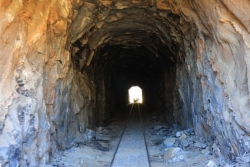 Our trip began Sunday morning. After hearing about train rides at the Pacific Southwest Railway Museum in Campo, my wife and I decided that rediscovering San Diego's East County heritage would be a great way to spend the day. So we drove east on Highway 94, which was recently designated a state historic highway. It's also one of the most scenic two-lane highways in our County.
Our trip began Sunday morning. After hearing about train rides at the Pacific Southwest Railway Museum in Campo, my wife and I decided that rediscovering San Diego's East County heritage would be a great way to spend the day. So we drove east on Highway 94, which was recently designated a state historic highway. It's also one of the most scenic two-lane highways in our County.
I found myself traveling back in time to when I was young, going on Sunday drives to the mountains with my parents in the late 1950s. Many historic sites from the '50s can still be seen along the route; if not for the modern cars it would be hard to tell the difference.
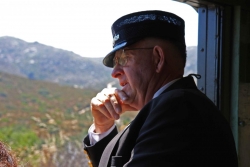
"All aboard!" conductor Richard Pennick shouted as we pulled into the station just in time to get our boarding pass for the Golden State Excursion morning train ride on the Pacific Southwest Railway. We learned that late arrivals who hold the train up for departure as they are speeding into the parking lot are cordially called "dusters" -- and we were almost among them.
 The conductor greeted us warmly and helped us board the train, which is powered by a 1939 Diesel-Electric locomotive. As the doors closed, the horn blew and the train started moving. The conductor introduced himself as he clipped our tickets. We heard the sounds of the train, clip clap, along with the squeaking of wheels, feeling the rhythm as the train rolled forward down the tracks.
The conductor greeted us warmly and helped us board the train, which is powered by a 1939 Diesel-Electric locomotive. As the doors closed, the horn blew and the train started moving. The conductor introduced himself as he clipped our tickets. We heard the sounds of the train, clip clap, along with the squeaking of wheels, feeling the rhythm as the train rolled forward down the tracks.
 Soon after leaving the train station we approached a road crossing near the Campo Trading Post Market. The crossing arm lowered and the train's horn blew, giving warning that we were coming so that traffic stopped for our train. Normally I am on the other side, driving the car and waiting on the train; at that moment I felt the power of the train.
Soon after leaving the train station we approached a road crossing near the Campo Trading Post Market. The crossing arm lowered and the train's horn blew, giving warning that we were coming so that traffic stopped for our train. Normally I am on the other side, driving the car and waiting on the train; at that moment I felt the power of the train.
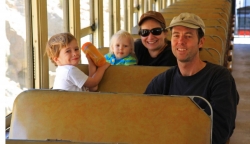 We meet a very nice family of four from Serra Mesa: John McMurria, Marion Wilson, three-year-old Lyttle and 17-month old Miller. The kids had a great time walking around between all three cars, parents in tow. They talked to the conductor, ate lunch that their parents had brought, and felt the wind on their faces as they stood next to the train’s brakeman, Bruce Paulis, while sucking on lollipops.
We meet a very nice family of four from Serra Mesa: John McMurria, Marion Wilson, three-year-old Lyttle and 17-month old Miller. The kids had a great time walking around between all three cars, parents in tow. They talked to the conductor, ate lunch that their parents had brought, and felt the wind on their faces as they stood next to the train’s brakeman, Bruce Paulis, while sucking on lollipops.
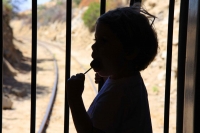 We enjoyed the beautiful natural sights as our journey continued through secluded high desert mountains of East County. During the first part of the ride, the locomotive was in the back, pushing the train cars. The brakeman was positioned in front, facing the direction we headed, keeping an eye out for hazards on the tracks.
We enjoyed the beautiful natural sights as our journey continued through secluded high desert mountains of East County. During the first part of the ride, the locomotive was in the back, pushing the train cars. The brakeman was positioned in front, facing the direction we headed, keeping an eye out for hazards on the tracks.
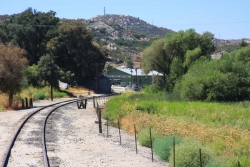 We savored blue skies, clean air and open spaces, observing the beauty of nature while enjoying the comforts of the train. We saw ranches, cattle, horses, mountain quail, manzanita growing from the sides of rock faces, wild turkeys under shady oak trees, and birds of prey soaring on lofty thermal air currents.
We savored blue skies, clean air and open spaces, observing the beauty of nature while enjoying the comforts of the train. We saw ranches, cattle, horses, mountain quail, manzanita growing from the sides of rock faces, wild turkeys under shady oak trees, and birds of prey soaring on lofty thermal air currents.
Our conductor explained in detail how this highly regulated train ride is run. The federal government inspects the train and has oversight of its operations. The people who run the train, restore old trains and operate the museum are all volunteers. Those who run the trains are well trained and must follow strict rules and regulations. Their love of the trains is obvious; you would think they were all highly paid professionals based on their approach to their tasks. (If you love trains, too, the museum is actively seeking more volunteers.)
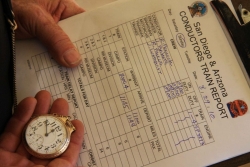
Each trainman carries a pocket watch-and all are synchronized before the train ever leaves the station. Many of the passengers had cameras and posed with the conductor,engineer and brakeman.
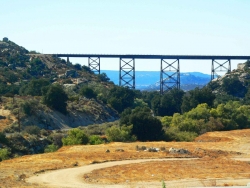
We passed a sign that read "Dog Patch" and learned that it originated from a 1950's biker bar that was located on old 94. We squeaked over the Campo Creek Trestle, which drops off to the dried river bed below, ending the first part of our journey at the international tunnel, where the Mexico and United States border's meet. (Editor's note: until recently, train trips to Tecate, Mexico were offered out of the Campo depot, including a section across an elevated trestle across a towering gorge. But a fire damaged tracks in Mexico; trips to Tecate, famed for its brewery and other attractions, may resume if repairs are completed south of the border.)
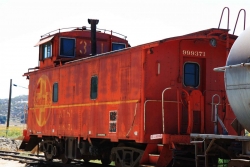 On the trip back to the station, we saw a sign marking the Pacific Crest Trail, which originates at the Mexican border and heads all the way north to Canada. Rail signposts state how far from San Diego we are (63, at one point). It's a tribute to the builder of this short rail, John D. Spreckles, that this line exists.
On the trip back to the station, we saw a sign marking the Pacific Crest Trail, which originates at the Mexican border and heads all the way north to Canada. Rail signposts state how far from San Diego we are (63, at one point). It's a tribute to the builder of this short rail, John D. Spreckles, that this line exists.
As we pulled in for the end of our hour-long journey, passing wildflowers in bloom, we learned that this short line also was used for taking freight and people to El Centro, where they could link up to trains leading to other parts of the country.
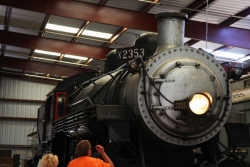
Our adventure was not yet over, since we took time to visit the Museum.
Founded in 1961, the Museum which houses over 80 types of railroad equipment to wonder over, walk through and touch. The Museum is a story of its own, with friendly hosts eager to answer questions and share their wealth of historical knowledge and lore.
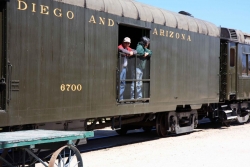
The Campo train ride and Pacific Southwest Railway Museum were delightful destinations that allowed us to experience riding the rails through San Diego's backcountry and bygone times.
The cost is affordable, too.Visiting the museum costs $5 for adults and $2.50 for children; the museum is open Saturdays and Sundays from 9 a.m. to 5 p.m., except for Christmas and New Year's weekends. Tickets to ride the Golden State train costs $15 for adults, $12 for seniors, and $5 for children 6-12. Check the website for a schedule of departure dates and times. The museum also seeks members, who receive discounts on tours, activities, gift shop purchases and more.Newsletter subscriptions are also available.
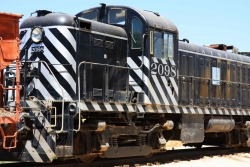
The Pacific South West Railway Museum and Campo Depot are located at the junction of State Highway 94 and Forest Gate Drive.
For more information, visit www.psrm.org or call 619-478-9937.







Comments
We all know that San Diego is
We all know that San Diego is one of the place that can offer many historical scenery and riding the trail is one of the most memorable moment in your adventurous life to see and discover the San Diego's historic past -